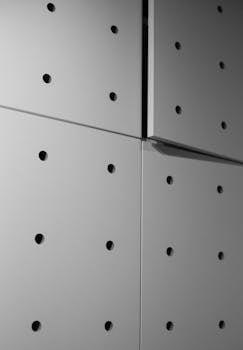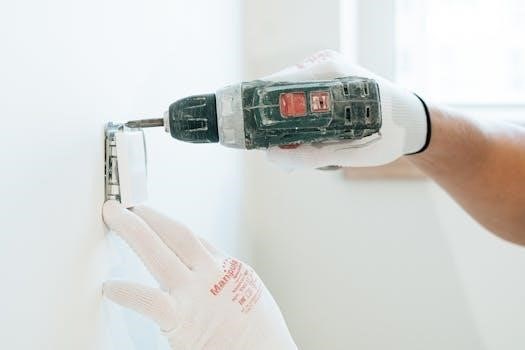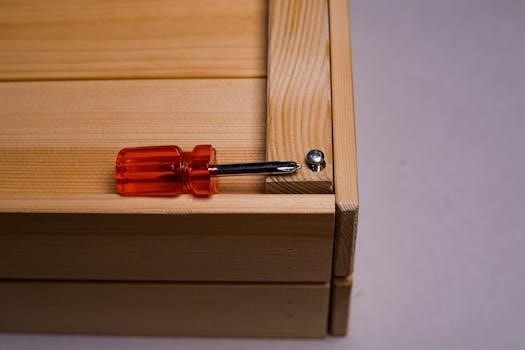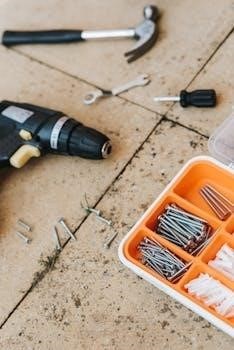Honeywell T3 Installation Overview
The Honeywell T3 thermostat is designed for user-friendly installation. It includes a UWP mounting system and comes with necessary hardware. The T3 series is suitable for users looking for a modern design with simple programming for remote comfort control. The package generally contains screws, anchors, and sometimes batteries.
Package Contents and Models
The Honeywell T3 thermostat package typically includes the T3 Pro thermostat unit itself, a UWP (Universal Wall Plate) mounting system, and a small decorative cover plate. You’ll also find screws and anchors for mounting, along with a set of AA batteries for powering the device. Specific models, such as the TH3110U2008 and TH3210U2004, are often included. Some packages also contain literature such as the installation instructions. Depending on the model, a receiver box might be included, especially for the wireless versions. The package contents ensure a complete setup.

Powering the T3 Thermostat
The Honeywell T3 thermostat can be powered by 2 AA batteries. Before starting any installation, always turn off the power at the breaker box to ensure safety during setup.
Power Options and Safety
The Honeywell T3 thermostat primarily utilizes battery power, typically requiring two AA batteries for operation. It’s crucial to ensure that the mains power is switched off before accessing any wiring to prevent short circuits or electrical hazards. Always prioritize safety during installation by turning off the power at the breaker or switch. This measure is essential to avoid potential electrical shock and ensure the safe and correct installation of your new thermostat. Remember to follow all safety precautions outlined in the installation manual.
Mounting System Installation
The Honeywell T3 utilizes a UWP mounting system. This system simplifies installation. Ensure the power is off. Mount the UWP securely using the provided screws and anchors; Refer to the manual for detailed instructions.
UWP Mounting System Instructions
Before beginning the mounting process of your Honeywell T3 thermostat, always ensure the power to your heating system is completely switched off at the breaker box or switch to guarantee safety. The T3 includes a UWP mounting system; position it on the wall where you want your thermostat. Use the included screws and anchors to securely affix the UWP to the wall. Make sure it’s level for optimal functioning. The mounting platform might allow for wiring from the back or below for convenience during installation.
Wiring the T3 Thermostat
Proper wiring is crucial for the Honeywell T3 thermostat. Always follow the specific instructions provided in the manual for correct connections. Ensure the power is off before accessing the wiring to prevent short circuits.
Wiring Connections and Precautions
When wiring the Honeywell T3 thermostat, it is imperative to prioritize safety and accuracy. Before initiating any wiring work, ensure that the mains power to the heating system is completely switched off at the breaker box or switch. This precaution is essential to prevent electrical shocks and potential damage to the thermostat or the heating system. Carefully follow the wiring diagram provided in the T3 installation manual. Make sure each wire is connected to the correct terminal, double-checking for accuracy. Incorrect connections can lead to malfunctions or system damage. The wiring can be done from below or from the back, by lifting the terminal platform.

T3 Thermostat Interface
The T3 thermostat features a large, clear display with a backlight for easy viewing. It utilizes simple icons and navigation for user-friendly operation and easy programming. The interface is designed to be intuitive.
Display, Icons and Navigation
The Honeywell T3 thermostat boasts a clear, fixed-segment display that incorporates a backlight, ensuring optimal visibility in various lighting conditions. Its interface employs simple, intuitive icons that represent different functions and modes, making it easy for users to understand the device’s current state. The navigation is designed to be user-friendly, allowing for straightforward access to settings and programming options. The overall design prioritizes ease of use, enabling users to effortlessly interact with the thermostat and control their home’s temperature settings. The display provides clear information, and the navigation minimizes complexity.

Programming and Scheduling
The T3 thermostat offers programmable scheduling, allowing users to set different temperatures for various times of the day. It provides options for 5/2 day or 7-day programming to suit user preferences and lifestyles.
Setting Schedules and Modes
The Honeywell T3 thermostat allows for easy schedule setting, enabling users to customize heating or cooling periods throughout the day. You can choose between different modes such as auto, heat, cool, or off, according to your needs. The device supports both 5/2-day and 7-day programming options, providing flexibility in creating schedules that fit your lifestyle. The T3 also offers a copy schedule function, making it simpler to duplicate settings for different days of the week. With user-friendly interfaces, setting schedules and modes is straightforward, making it a convenient option for managing your home’s temperature.
Manual Operation and Overrides
The Honeywell T3 allows manual operation through simple controls. Users can temporarily override programmed schedules as needed. This feature provides immediate adjustments to temperature settings for added convenience and comfort.
Using Manual Functions and Overrides
The Honeywell T3 thermostat offers straightforward manual functions, enabling users to adjust settings directly. The manual override feature allows temporary deviations from the programmed schedule, granting immediate control over the temperature. This is useful when you need to change the temperature outside of your usual set schedule. This function is easily activated through the unit’s interface, providing intuitive control for quick changes. The override can be set for a specific period, after which the thermostat will revert to its programmed schedule, ensuring energy efficiency.
Troubleshooting
Common issues with the Honeywell T3 include display problems, wireless signal loss, and thermostat malfunctions. Check power supply, connections, and consult the manual for solutions. If issues persist, seek professional help.
Common Issues and Solutions
Experiencing a blank display on your Honeywell T3 often indicates a power issue; ensure the batteries are fresh or power supply is active. If the thermostat flashes “Wireless signal lost,” reposition the unit or receiver box to improve connectivity. Incorrect wiring can lead to operational problems, so double-check all connections based on the manual’s diagrams. If the heating or cooling system doesn’t respond to thermostat commands, verify that the system is functioning. For unresponsive buttons, try a factory reset or contact support for further assistance. Ensure that the thermostat is properly mounted on the wall, not loose. If the issue is about setting the schedules, consult the manual for the right steps.

Additional Resources
For further assistance, consult the provided manuals and installation guides. Honeywell’s website offers detailed information and support. Online videos offer visual guidance for installation and setup. You can also contact Honeywell support for direct help.
Manuals and Support
Comprehensive installation guides and user manuals are available for the Honeywell T3 thermostat. These resources provide detailed instructions for wiring, mounting, and programming. Online, you can find PDF versions of these manuals for easy access and reference. Additionally, Honeywell’s official website offers extensive support materials, including FAQs and troubleshooting tips. For visual learners, several online videos demonstrate the installation process step-by-step. Should you encounter any difficulties, reaching out to Honeywell’s customer support team is an option for personalized assistance. They can offer guidance on specific issues you may face during the setup or operation of the thermostat. Make sure to refer to the correct manual for your specific model, whether it’s the wired or wireless version.